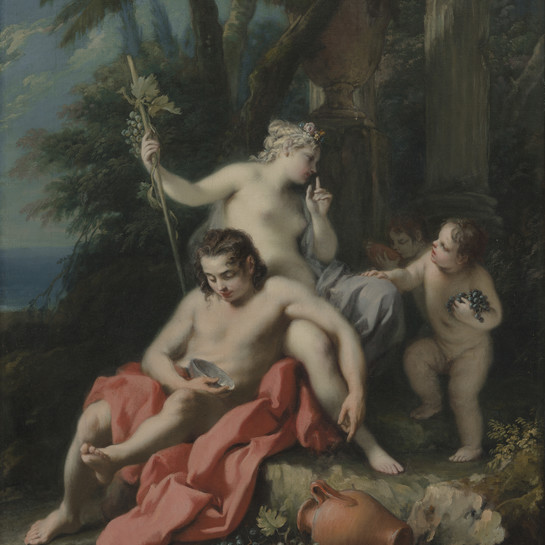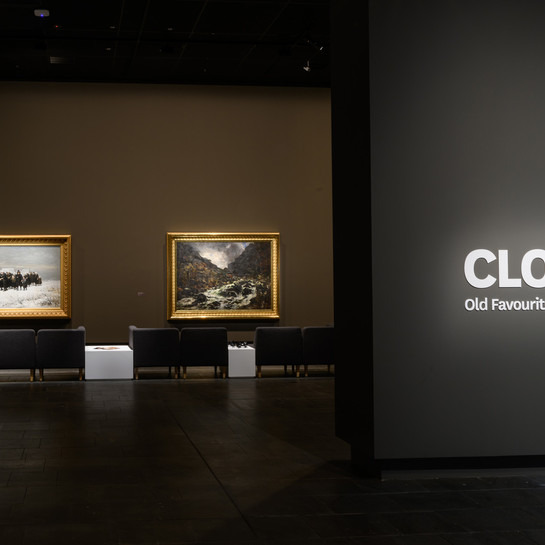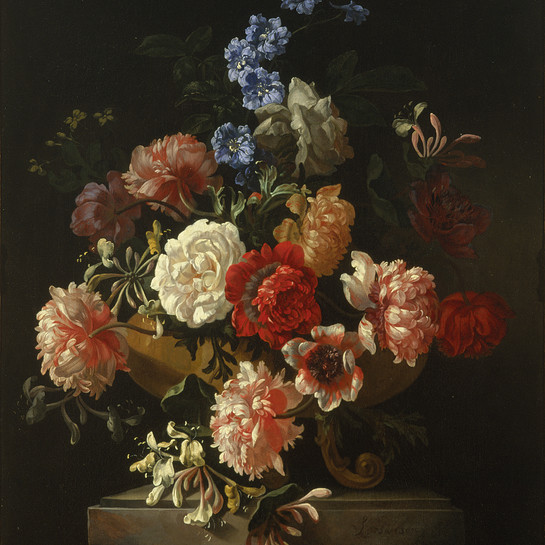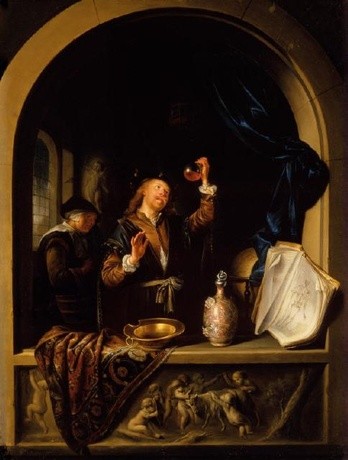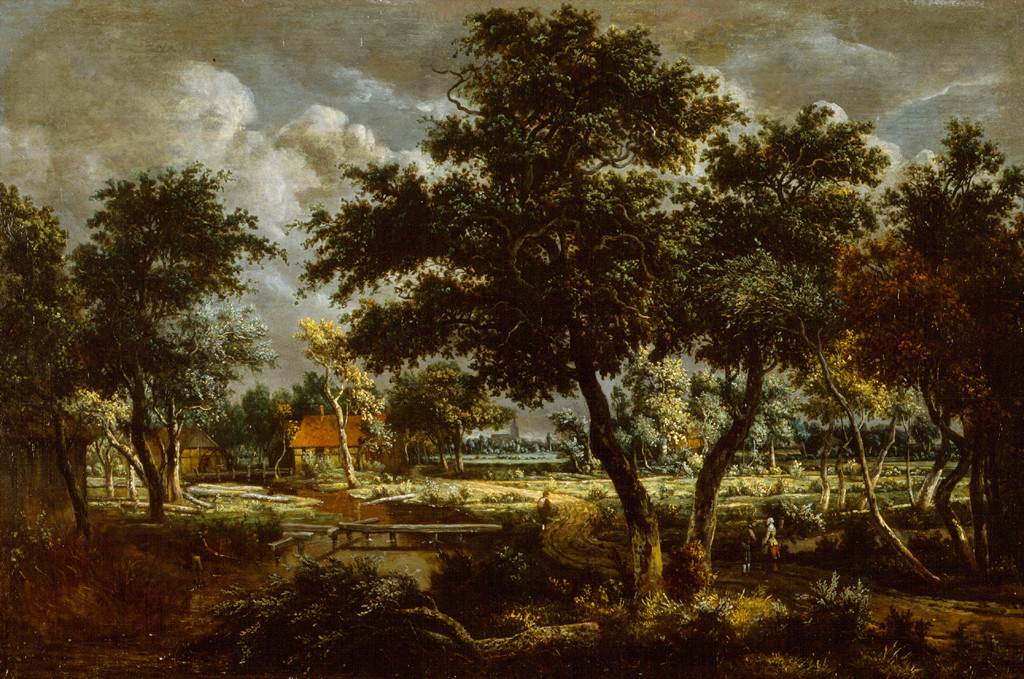Gerrit Dou
Netherlands, b.1613, d.1675
The Physician
- 1653
- Oil on copper
- Heathcote Helmore Bequest, 1965
- 720 x 600 x 50mm
- 69/292
Tags: animals, arches, birdcages (containers), bleeding bowls, books, bottles, carpets, examination (function), globes (cartographic spheres), goats, masks (costume), memento mori, people (agents), physicians, pregnancy, putti (motifs), reliefs (sculptures), skeleton and skeleton components, urine, windows
Gerrit Dou was Rembrandt van Rijn’s earliest and most successful student, and became highly sought after by European royalty and aristocratic patrons for his captivating, highly detailed works. His paintings were packed with intriguing elements waiting to be read. Here, a physician based on Dou himself carefully analyses a jar of urine for a pregnancy test.
(Out of Time, 23 September 2023 – 28 April 2024)
Exhibition History
See this work extra close-up.
Absence, 6 May – 20 August 2023
This painting’s central figure is a piskijker, a Dutch word for a doctor who specialises in the study of urine. In this case, he is thought to be conducting a pregnancy test, carefully watched over by the woman behind him. He is surrounded by symbols of his skill and knowledge, including a textbook of human anatomy. Other elements in Gerrit Dou’s carefully constructed painting draw our attention to this invisible potential life: the illustration of a skeleton on the open page was a familiar vanitas symbol reminding viewers of the brevity of mortal life, while the sculpted ledge under the window shows a scene of sinful pleasure – perhaps a clue to the circumstances of conception.
Persistent Encounters, 10 March 2020 – 19 September 2021
Gerrit Dou was Rembrandt van Rijn’s first student, training with him in Leiden while in his teens, and for a significant period he eclipsed his master’s reputation. Rich with coded narratives, his extraordinarily detailed paintings were prized throughout Europe by the wealthiest royal and aristocratic collectors. The figure examining the bottle of liquid in this painting is believed to be a self-portrait, and is identified as a piskijker– a medical practitioner skilled at studying urine, here for a pregnancy test. Symbols of his skill and learning are prominent, including a celestial globe and carefully positioned anatomy textbook. The skeleton on the open page leaning like a gravedigger on his spade is the ultimate symbol of vanitas – a reminder of the fragile brevity of a human life. At the same time it looks with anticipation to a child to come.
New Dawn Fades, 10 November 2018 – 23 February 2020
Gerrit Dou was a leading figure in Dutch painting during the 1600s – a period often referred to as the Golden Age. A pupil of Rembrandt van Rijn, Dou favoured painting interior scenes and his work is renowned for its minute detail and immaculate finish. In The Physician a learned man examines the contents of a flask thought to contain urine, a test frequently used to diagnose pregnancy in the seventeenth century. Although it is a small painting, it is full of symbolism: the putti playing with a goat in the frieze represents sinful pleasure and the medical book opened on a page featuring a human skeleton leaning against a shovel represents a gravedigger, a memento mori, or reminder of our own mortality.
Treasury: a generous legacy, 18 December 2015 - 4 December 2016
Gerrit Dou, a leading figure in Dutch painting ’s Golden Age, was Rembrandt’s first pupil for three years from the age of fourteen in 1628. Before long, he had eclipsed his master’s reputation; his meticulous, highly detailed paintings were prized by the wealthiest collectors.
The Physician’s earliest documented owner is Somerset- born Henry Francis Gray, who reached Port Lyttelton aged eighteen in 1856 and went into farming in Canterbury. 25 years later, Gray was commended in local newspapers for lending this treasure for the Canterbury Society of Arts’ first exhibition in 1881. Passing through family lines, it was bequeathed to the Gallery in 1965 by his great-nephew, the prominent Christchurch architect Heathcote Helmore.
Gerrit Dou’s prosperous-looking physician examines what is thought to be a urine sample, apparently testing for pregnancy. The motif of a physician examining the contents of a flask often appears in Dutch genre painting of the 17th century. ‘Genre’ painting is where people and everyday activities are shown in a natural setting. Dou was a founder member of the Leiden School of fijnschilders (fine painters) whose work was finely detailed and precisely painted. Dou’s skills in engraving and glass painting are reflected in the minute scale and high level of detail in his paintings. Dou was born in Leiden. Following his apprenticeships, he entered the studio of Rembrandt van Ryn (1606 -1669) in 1628 but his style developed in a different way. In 1631, when Rembrandt moved to Amsterdam, Dou set up his own studio in Leiden. He concentrated on portraits, genre and still life subjects and by 1660 was held in high regard throughout Europe, having become very wealthy through sales of his art.
(Label date unknown)
In this 17th century Dutch genre work the focus is on an anonymous but clearly prosperous physician. His equipment is arranged around him and includes an astrological globe which was thought to profoundly influence the temperaments and hence the health of people at that time. Arranged on the bench is the latest medical text, a very innovative and influential volume by Versalius 'De humani corporis fabrica libra septem'. The full-page illustration shows a skeleton leaning on a gravedigger's spade. This is a typical momento mori (reminder of human mortality) and is joined in this work by numerous other emblematic signs of love and marriage, that would have been easily read by the viewers of the times. Physicians were a popular subject with Dou, who painted at least four other versions of this subject, set like this one in an alcove.
Ernest Gray, the maternal grandfather of Heathcote Helmore is thought to have brought this painting to New Zealand in 1853. On Helmore's death in 1965 it was bequeathed to the Gallery.
(Label date unknown)

![Andreas Cellarius Hypothesis Ptolemaica Sive Communis Planetarum Motus Per Eccentricos Et Epicyclos Demonstrans [The Ptolemaic Hypothesis or Common Representation Demonstrating the Planetary Motions through Eccentrics and Epicycles] 1661. Hand-coloured engraving. Collection of Christchurch Art Gallery Te Puna o Waiwhetū, William A. Sutton bequest, 2000](/media/cache/05/97/05970cdff0f6b3264062d69bf2aa90f5.jpg)
